[117] You've come just in time, Chardin, to recreate my eyes that your colleague Challe had mortally afflicted1. So here you are again, great magician, with your silent compositions! How eloquently they speak to the artist2! what they tell him about the imitation of nature, the science of color and harmony! How the air circulates around these objects! Sunlight does not save better the disparities of the beings it illuminates3. This is the one that hardly knows friendly colors, enemy colors.
If it is true, as the philosophers say, that there is nothing real but our sensations4; that neither the emptiness of space, nor the very solidity of bodies is perhaps nothing in itself of what we experience ; let them teach me, these philosophers, what difference there is for them four feet from your paintings between the Creator and you5.
Chardin is so real, so true, so harmonious, that whatever you see on the canvas only inanimate nature, vases, cups, bottles, bread, wine, water, grapes, fruit, pâtés, it sustains6, and perhaps takes you away from two of the finest Vernet7, next to which he didn't swing to put himself8. It is, my friend, as in the universe9, where the presence of a man, a horse, an animal, does not destroy the effect of a piece of rock, a tree, a stream ; the stream, the tree, the piece of rock, are of less interest without doubt than the man, the woman, the horse, the animal, but they are equally true.
[118] I must, my friend, communicate to you an idea that comes to me, and which perhaps would not come to me in another moment, is that this painting, which is called genre10, should be that of old men or those born old. It requires only study and patience. No verve11; little genius; little poetry12; much technique and truth; and then, that's it. Now, you know that the time when we set ourselves to what is called, according to usage, the search for truth, philosophy, is precisely the time when our temples turn gray, and when we would have bad grace to write a gallant letter. A propos, mon ami, de ces cheveux gris, j'en ai vu ce matin ma tête tout argentée, et je s'écrichant comme Sophocles, lorsque Socrate lui demandait comment allaient les amours : A domino agresti et furioso profugi, I escape the savage and furious master13. I'm having all the more fun chatting with you here, as I'm only going to tell you one word about Chardin; and here it is. Choose his site14; arrange on this site the objects as I shall indicate them to you, and be sure that you will have seen his paintings. He painted The Attributes of the Sciences, The Attributes of the Arts, those of Music, Refreshments, Fruits, Animals. There's almost no need to choose; they're all of the same perfection. I'll sketch them for you as quickly as I can.
45. The Attributes of the Sciences.
From the same15.
We see, on a table covered with a reddish carpet, going, I believe, from right to left16, books laid on edge, a microscope, a [119] bell, a globe half-hidden by a green taffeta curtain, a thermometer, a concave mirror17 on its stand, a lorgnette18 with its case, rolled maps, a piece of telescope.
This is nature itself, for the truth of form and color; the objects separate from each other, advance, recede, as if they were real; nothing more harmonious; and no confusion, despite their number and the small space.
46. The Attributes of the Arts19. (#001178)
From the same.
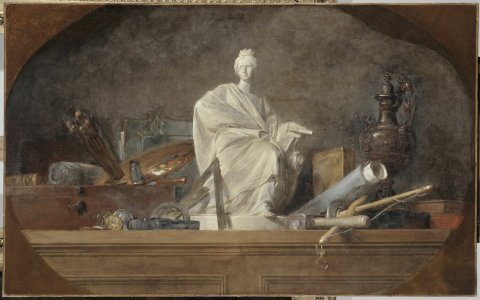
Here are flat books, an antique vase, drawings, hammers, chisels, rulers, compasses, a marble statue, brushes, palettes, and similar objects. They are placed on a sort of balustrade. The statue is that of the Grenelle fountain, Bouchardon's masterpiece20. Same truth, same color, same harmony.
47. The Attributes of Music (#001177)
Of the same.
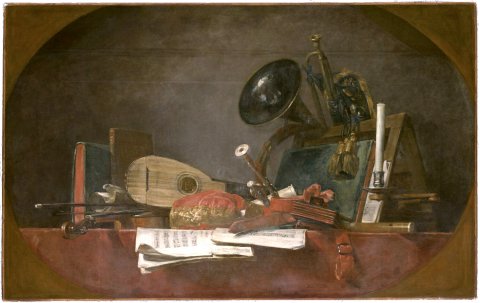
The painter has spread out on a table covered with a reddish carpet, a host of various objects, distributed in the most natural and picturesque manner21 ; it's an upright lectern; it's in front of this lectern a torch [120] with two branches22 ; behind it is a horn23 and a hunting horn, the concave part of which can be seen over the lectern; these are oboes24, a mandora25, music papers spread out, the neck of a violin with its bow, and books laid on edge. If an evil animate being, a snake were painted as true, it would frighten. These three paintings are 3 feet 10 inches wide by 3 feet 10 inches high26.
48. Refreshments
From the same.
Fruits and animals. Imagine a factory27 square of grayish stone, a kind of window with its projection and cornice. Throw in with as much nobility and elegance as you can, a garland of coarse verjuice28 that extends along the cornice, and falls on both sides. Place inside the window a glass full of wine, a bottle, a loaf of half-ripe bread, other carafes cooling in an earthenware bucket, an earthen jug, radishes, fresh eggs, a salt shaker, two steaming served coffee cups29, and you'll see Chardin's painting. This factory, of wide, plain stone, with this garland of verjuice decorating it, is of the greatest beauty; it's a model for the façade of a temple of Bacchus.
48. Counterpart to the previous painting.
The same stone factory, around it, a garland of large white muscat grapes ; inside, peaches, plums, jugs of lemonade [121] in a green-painted tin bucket, a lemon peeled and cut down the middle, a basket full of scalded30, a masulipatan handkerchief31 hanging outside, a carafe of orgeat32, with a glass that's half full of it. How many objects! How many shapes and colors! And yet what harmony! what repose! the handkerchief is astonishingly soft.
48. Third painting of refreshments, to be placed between the first two. (#001170)
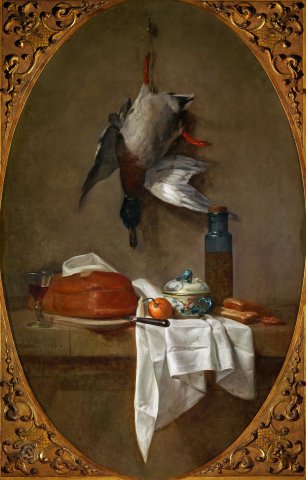
If it's true that a connoisseur can't do without at least one Chardin, let him grab this one. The artist is beginning to age. He has sometimes done as well; never better. Suspend a river bird by the leg. On a sideboard below, suppose whole and broken cookies, a jar corked and filled with olives, a painted and covered Chinese bowl, a lemon, a napkin unfolded and carelessly thrown away, a pâté on a wooden log, with a glass half-full of wine. This is where we see that there are few ungrateful objects in nature, and that the point is to return them. The cookies are yellow, the jar is green, the napkin white, the wine red, and this yellow, this green, this white, this red, set in opposition, recreate the eye with the most perfect harmony. And don't think that this harmony is the result of a manner33 weak, soft and licked, [122] not at all, it's everywhere the most vigorous touch. It is true that these objects do not change under the eyes of the artist34. As he saw them one day, so he finds them the next. Not so with animate nature. Constancy is the attribute only of stone35.
49. A Basket of Grapes (#001169)
From the same.
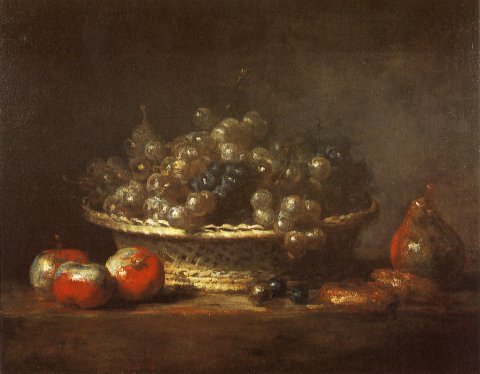
That's the whole picture. Just scatter around the basket a few separate grapes, a macaron36, a pear, and two or three pommes d'api37. It will be agreed that separate grapes, a macaroon, isolated api apples are favorable neither in form nor color; however let us see Chardin's painting.
49. A Basket of Plums. (#001160)
From the same.
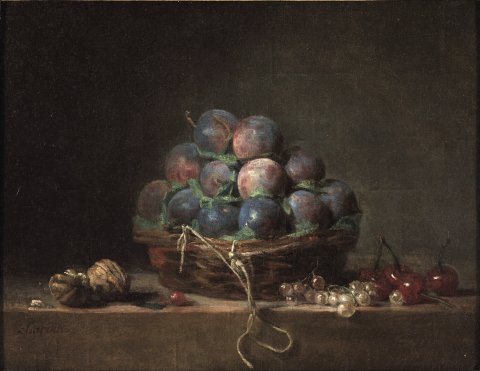
Place a wicker basket full of plums on a stone bench, with a wicked piece of string as a handle, and throw around some walnuts, two or three cherries and a few grapes.
This man is the Salon's first colorist and perhaps one of painting's first colorists. I do not forgive this impertinent Webb for having written a treatise on art, without quoting a single Frenchman38. Nor do I [123] forgive Hogarth39 for saying that the French school had not even one mediocre colorist. You have lied about it, Mr. Hogarth; it is, on your part, ignorance or platitude. I am well aware that your nation has the tic to disdain an impartial author who dares to speak of us with praise40: but must you basely court your fellow citizens at the expense of truth? Paint, paint better, if you can. Learn to draw, and don't write. We English have two very different manias. Ours is to praise English productions; theirs is to depreciate ours. Hogarth was still alive two years ago41. He had stayed in France42; and it's been thirty years since Chardin was a great colorist. Chardin's style is particular. It has in common with the heurtée43 manner, that up close you don't know what it is, and that as you move away, the object is created, and ends up being that of nature44. Sometimes you like him almost equally from near and far. This man is above Greuze by the whole distance from earth to heaven, but only in this respect. He has no style; I'm wrong, he has his own. But since he has his own way, he should be wrong in some circumstances, and he never is. Try, my friend, to explain this to yourself. Do you know of a style in literature that is suitable for everything? Chardin's kind of painting is the easiest; but no living painter, not even Vernet, is as perfect in his.
I'm reminded of two Paysages by the late Deshays of which I've told you nothing; it's that it's nothing, it's that they're both of a hard as hard... as these last words.
Notes
Diderot has just harshly criticized Challe's Hector reproaching Pâris for his cowardice.
Asyndète: Chardin's praise is a paradoxical one: although his still lifes are at the very bottom of the genre hierarchy, he is a genius. His compositions don't tell a story, because they're not history paintings, and yet they're eloquent. But they really speak only to artists, that is, to a public capable of appreciating the technical prowess they represent.
In nature, colors, no matter how disparate (even if they swear), always harmonize with each other: natural light produces this harmonization that allows us to move seamlessly from one to the other. This is not the case in painting, where certain juxtapositions of colors hurt the eye: to remedy this, we need to "save their disparity", linking them by introducing into the previous color a little of the color that follows. Chardin does this so well that he can rival the sun...
In Trévoux's dictionary, disparate is a feminine noun, there is no adjective: "This word is Spanish, but many use it to explain great inequalities of spirit, things said or done inappropriately. Inaequilitas, disparilitas. This man has wit & merit, but he sometimes has great disparities, he says & does many things against the grain."
There is no entry for "Disparate" in Pernéty's Dictionary, which deals with this problem in the article Sympathy: "is said of colors which by mixing give rise to another pleasing to the sight. We then say that such and such a color are friends, that they have sympathy, union between them. Blue, for example, broken with yellow, forms a green that pleases the eye: blue on the contrary, mixed with vermilion, produces a sour, harsh and unpleasant color, from which we conclude that there is antipathy between blue and vermilion."
On friendly and enemy colors, see the Essais sur la peinture, DPV XIV 355.
Relating to Berkeley's formula, esse est percipere aut percipi. Here's what Berkeley writes: "For what is said of the absolute existence of things which do not think, an existence which would be unrelated to this fact that they are perceived, this is what is perfectly unintelligible to me. Their esse consists in the percipi, and it is not possible for them to have any existence, outside the thinking minds or things that perceive them." (A Treatise Concerning the Principles of Human Knowledge, Dublin, 1710 ; Les Principes de la connaissance humaine, trad. Charles Renouvier, A. Colin, 1920, I, §3)
Diderot later addresses the same praise to Vernet's landscapes: "et quels tableaux! c'est comme le Créateur, pour la célérité; c' est comme la nature, pour la vérité."
He supports the comparison.
Maybe you'll forsake the two Vernets next door and focus on Chardin.
As upholsterer of the Salon, it was Chardin who decided on the hanging, and therefore the placement of the paintings.
Like in the real world.
Diderot distinguishes only two genres of painting, history painting and genre painting. In the preamble to the "Sculpture" section of the Salon de 1765, he writes: "Painting is divided into technique and ideal; and both are subdivided into portrait painting, genre painting, and historical painting. Sculpture has more or less the same divisions." (DPV XIV 285-6) For Diderot, Chardin's still lifes are genre painting...
Diderot is even more explicit.
Diderot is even more explicit in the Essais sur la peinture : "It seems to me that the division of painting into genre painting and history painting makes sense, but I would like to see the nature of things consulted a little more in this division. [...] It was necessary to call genre painters the imitators of raw and dead nature; history painters, the imitators of sensitive and living nature" ("Paragraphe sur la composition où j'espère que j'en parlerai", DPV XIV 398-9).
" Verve, s. f. Certaine fureur, ou émotion d'esprit qui réveille le génie des Poëte, des Peintres, des Musiciens, & des gens qui travaillent d'imagination. Animi impetus, concitatio, æstus, furor. Wine warmed him up, put him in his poetic verve." (Trévoux)
Almost synonymous terms that characterize, first punctually (verve), then increasingly globally (poetry) the artist's capacity for invention.
Bene Sophocles, cum ex eo quidam iam affecto aetate quaereret, utereturne rebus veneriis, di meliora ! inquit ; ego vero istinc sicut a domino agresti ac furioso profugi. (Sophocles answered well when, already affected by age, he was asked if he had recourse to the things of love: Gods forbid! I escape from it as from a savage and furious master. Cicero, De senectute, §46. Cicero takes up a Platonic theme. See The Republic, 329c)
Diderot reuses this term in the Promenade Vernet du Salon de 1767 to characterize the 7 promenade sites that would turn out to be the 7 paintings exhibited by Vernet.
The painting is lost. See, however, the 1731 version, #007997.
Diderot proceeds rather, for the description, in the opposite direction to that of the reading.
Grossissant.
" Lorgnette, s. f. Magnifier used by those with low eyesight, & those who wish to consider certain objects accurately, such as medals, engraved stones, &c. There are two kinds of lorgnettes, some have two lenses enclosed in a small case, less long than the finger; they are used only by those with low vision; it is a kind of spyglass; the others are only a magnifying glass surrounded by a circle of horn, or tortoiseshell, with a small handle. These are still called louppes today, & never lorgnettes." (Trévoux)
Catherine II commissioned a copy of this painting from Chardin in 1766, which is preserved at the Hermitage, #008002. Chardin also made a version for Pigalle, preserved in Minneapolis, #012970. In both 1766 versions, Chardin replaced Bouchardon's statue with Pigalle's Mercure attachant ses talonnières, #001836.
See #021205.
" Picturesque, adj. de t. g. It is said Of the arrangement of objects, the aspect of sites, the attitude of figures, that the Painter believes more favorable to expression. This bizarre, frightening site is quite picturesque. The aspect of this marine is more picturesque at sunset, than at any other time. This menacing figure is well thought out, its attitude is picturesque. It is said by extension Of anything that paints to the mind. A picturesque description. A picturesque ballet." (Dictionnaire de l'Académie, ed. 1764) The word is not in the Trévoux.
In fact, a simple candlestick.
A trumpet.
In fact, the blowpipes of a musette, or bagpipe. See #008757.
" Mandore, subst. fem. Musical instrument which is a [sic] diminutive & a species of small lute, of which it has the figure. Cithara minor, pandoron. The mandôre of the Ancients had only four strings, of which the chanterelle served to play the subject, & it was plucked with the index finger, to which a feather was attached, which they called plectrum, or pecten. The other three strings made an octave filled with its fifth, & were milled one after the other by the pource. Athenaeus mentions a mandôre which he calls pandôron. There are even now mandôres with only four strings. But they are sometimes made with six strings, & even with a greater number to imitate the lute more; & then it is called mandôre luthée. The Turks have a species of mandôre which they play." (Trévoux)
Diderot recopies the dimensions given by the booklet, and this is an obvious error as the paintings are not square. It should probably read "These three paintings are 4 feet 10 inches wide by 3 feet 10 inches high."
" Fabrique, in terms of Painting, is said of buildings in general, but more particularly of those which have some regularity of Architecture, or at least which are more apparent. The fâbriques are of great ornament in the landscape. De Pile. Le Poussin a peint dans ses ouvrages des fabriques Romaines d'une grande élégance, & Bourdon des fabriques Gottiques, qui toutes Gottiques qu'elles sont, ne laissent pas de jeter un air sublime dans les paysages. Id." (Trévoux)
" Verjus, s. m. Grape still green & sour, which has been picked before it is ripe. It has a greenish color, & an acid & stiptic taste." (Trévoux)
See for example the steaming cup of Bocal d'abricots, #001173.
" Eschaudé, s. m. Cake made in the shape of a triangle, or heart, with eschaudée [=boiled] dough, water, salt, & sometimes with butter & eggs. Crusculum triquetrum. We eat eschaudez bénits on Holy Thursday. Du Cange says they are called in the old Tîtres eschaudati panes, and that eschauder comes from excladare." (Trévoux)
" Masulepatan, Musilipatan, s. m. Proper name of a town on the almost Isle of India below the Ganges. Maselepatanum, Masuleportus." (Trévoux) Machilipatnam is in fact located much further south, at the mouth not of the Ganges, but of the Krishna River, in Andra Pradesh, on the Coromandel coast. From the end of the 17th century, the Chofelins, Armenians from Marseille, imported to France the technique of Masulipatnam indiennes, cotton fabrics painted or printed in two colors, madder red and indigo blue. In a 1683 memorandum to the Lyon Chamber of Commerce, the Compagnie des Indes ranked Salamporis, "strong in thread, tight and well bleached", especially those from Masulipatam and the Coromandel coast, at the top of its import list. The craze for these fabrics was such that it compromised the traditional textile industry: sale and manufacture were banned from 1686 (Royal Edict of October 26), giving rise to considerable smuggling, and were not legally resumed until 1759 (Arrêt du Conseil Royal, on the intervention of Mme de Pompadour). Trévoux's dictionary is more explicit in its 1771 edition, adding: "Masulipatan, s. m. On nomme ainsi les toiles des Indes à l'aunage. They are the best painted and the finest made there. | Masulipatan. We also give this name to handkerchiefs from India. (These are the neck handkerchiefs with which Ladies adorn their throats.)
" Orgeat, s. m. Sorte de boisson rafraîchissante, faite avec de l'eau, du sucre, & de la graine pilée des quatre semences froides. A glass of orgeat. An orgeat caraffe." (Dictionnaire de l'Académie, 1740. In the 1762 edition, the recipe also includes almond.)
A way of painting, a style.
This is the argument usually used to belittle still life compared to history and genre paintings, which involve posing live models who will never adopt exactly the same attitude from one day to the next.
This very presupposition would fall for Diderot, in Le Rêve de D'Alembert : for a materialist, there is no boundary between the animate and the inanimate, "il faut que la pierre sente".
There are actually two.
" Api. A kind of apple. Malum apiolum. It is small, & colored a rather bright red. On la conserve long-tems." (Trévoux)
Daniel Webb, An Inquiry Into the Beauties of Painting; and Into the Merits of the Most Celebrated Painters, Ancient and Modern, London, Dodsley, 1760; Recherches sur les beautés de la peinture et sur le mérite des plus celébresPeintres anciens & modernes, trans. from English by M. B[ergier], Paris, Briasson, 1765. Diderot, who had the French translation before publication, reported on it in the Correspondance littéraire of January 15, 1763. See DPV XIII 308sq. Webb essentially evokes the painting of the Ancients, based in particular on Pliny's testimony.
William Hogarth, The Analysis of Beauty, London, Reeves, 1753. the work would not be translated into French until 1803. Diderot therefore read it in English, perhaps at the instigation of Allan Ramsey, whom he met at the Vanloo home (letter to Sophie Volland, September 8, 1765, CFL V 931).
The Seven Years' War (1756-1763), which pitted France against England in particular, continued in New France, where peace was not signed until 1766. Hogarth caricatured the French in an engraving from 1756.
Hogarth died on October 26, 1764. His last engraving is entitled Tailpice - The Bathos, i.e. Cul-de-lampe, ou la Chute du sublime. See #021208.
Hogarth stayed briefly in Paris in 1743 and made a detour to Calais in 1748, which almost turned out badly: the War of Austrian Succession wasn't over, and he was accused of espionage!
" Heurté, adj. (Painting.) one calls heurté, especes de tableaux qu'on devroit nommer esquisse, où l'on voit que le feu de l'imagination mal digeré.
It is said, such a painter does but heurter paintings; that is but heurté; it is necessary that small paintings be finished, & not heurtés." (Encyclopédie, VIII, 196a, 1765) Diderot's position vis-à-vis the heurtée manner is much more nuanced.
" Two kinds of painting ; one which, placing the eye as close to the painting as possible without depriving it of its faculty of seeing distinctly, renders the objects in all the details it sees at that distance, and renders these details as scrupulously as the principal forms, so that as the spectator moves away from the painting, as he loses these details, until at last he arrives at a distance where everything disappears ; so that as he approaches this distance where everything is blurred, the forms gradually begin to be discerned and successively the details to be recovered, until the eye returned to its first and least distance, it sees in the objects of the painting the slightest and most minute varieties. [...] But there is another painting which is no less in nature, but which imitates it perfectly only at a certain distance, it is, so to speak, imitative only in one point: it is that in which the painter has rendered vividly and strongly only the details he has seen in the objects at the point he has chosen; beyond this point, we see nothing more, it is even worse below it." (Essais sur la peinture, "Examen du clair-obscur", DPV XIV 367)
Les Salons de Diderot (édition)
Archive mise à jour depuis 2023
Les Salons de Diderot (édition)
Salon de 1763
Préambule du Salon de 1763
Louis-Michel Vanloo (Salon de 1763)
Deshays (Salon de 1763)
Greuze (Salon de 1763)
Sculptures et gravures (Falconet, Salon de 1763)
Salon de 1765
La Chaste Suzanne (Carle Vanloo, Salon de 1765)
Boucher (Salon de 1765)
La Justice de Trajan (Hallé, Salon de 1765)
Chardin (Salon de 1765)
La jeune fille qui pleure son oiseau mort (Greuze, Salon de 1765)
La Descente de Guillaume le Conquérant en Angleterre (Lépicié, Salon de 1765)
L'antre de Platon (Fragonard, Salon de 1765)
Sculpture (Salon de 1765)

